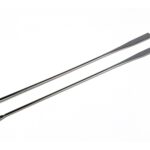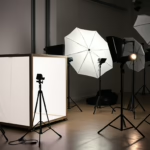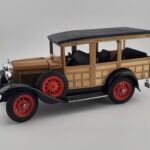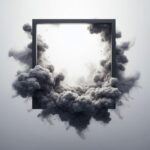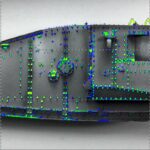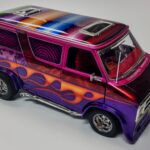Explaining Scale Model Filters
The purpose of a filter is not to necessarily change the base colour, rather give it a more realistic look.
Think of that sparkling clean, not a speck of dust on it, brand new, black or white car in the automotive showroom you are about to buy. After driving it home, parking it in the garage or leaving it parked outside overnight, the vehicle now has a filter applied to the paint surface, compliments of mother nature and environmental particulate.
Our brain plays tricks on us, what we see is a sparkling brand new paint job, not noticing the ever-present and gradual buildup of a faint layer of environmental accumulation on the finish. Within days, the environmental filter is now noticeable because it is more pronounced. With each passing day, the white or black finish becomes another tone of white or black, both shifting towards light and dark grey, respectively. The clear coat on the car paint doesn’t alter the surface transition from the filter effect.
The same effect applies to newly built military vehicles and aircraft fresh from the factory. Within days the same colour panels will start to take on different modulated hues, subtle colour shifts. On unpainted aircraft, aluminum panels will take on slight colour shifts especially those exposed to heat.
Filters, in short, will give the vehicle, aircraft or naval vessel a realistic in-service look.
Filters can be likened to Glazes used on Fantasy Miniature Figures.
What are FILTERS
The quality of the colour medium and pigment size has a bearing on the quality of the FILTER. Pigments 2-microns in size are considered superior. FILTERS are transparent, adding tonality subtleties to the underlying base coat.
To put 2-microns in perspective, invisible dust particles suspended in the air are 5-microns or less. A human hair is about 70-microns +/- 20-microns.
High-quality Artist Oil Paints contain the smallest pigment sizes. Depending on the colour, pigment sizes range from 5-microns to 0.1-microns. The better the brand, the superior the pigment refinement.
MIG Production Filters use 2-micron pigment sizes.
The science of colour is in play, it’s important to know what filter colour works with a particular base paint hue and chromatic value. Not all colours work.
FILTERS are applied using synthetic brushes over natural hair brushes for the best result. FILTERS are applied by brush in transparent layers, allowed to dry between each layer application.
FILTERS can be skillfully applied using an airbrush operating with low air pressure. The use of a MAC Valve (Micro Air Control) will dial in the best low pressure ideally suited for spraying FILTERS.
Types of FILTERS
FILTERS are both additive and subtractive, meaning they are applied (additive) and altered or removed partially or completely (subtractive) while wet using clean solvent along with a clean brush or paper towel.
- Enamel (Unifying Filter) – Transparent, Solvent-based, Mineral Spirits, White Spirits (Europe), regular (smells like diesel) or odourless (higher refining to remove sulphur causing the diesel odour).
- Oil Paint Filter (Unifying Filter) – Transparent, Solvent-based, Mineral Spirits, White Spirits (Europe), regular (smells like diesel) or odourless (higher refined to remove sulphur causing diesel odour). The oil paint is in liquid suspension.
- Oil Paint Palette Filter (Modulation Filter) – Opaque, small related dabs from defined, oil paint colour palette hues, applied directly to the surface and blended using a synthetic brush dampened (excess solvent wicked off) using Mineral Spirits, White Spirits (Europe), regular or odourless. Brush-work and the use of thinner determine the overall transparent or semi-transparent hue modulation results. An advanced Filter Technique.
- Acrylic Filter (Modulating and Unifying Filter) – Water-based, thinned with water (distilled for best results) or proprietary thinner with medium and retarder. Requires extensive testing and experience. Acrylic Filters are often referred to as Glazes.
FILTER Recipe
FILTERS are typically 1 part paint to 8 to 12 parts thinner. The higher the quality of the paint, the smaller the pigment size and the better the colour source. Experimentation is required to determine what solvent ratio is best for the colour in use.
- FILTER Ratio 1:8 to 1:12 parts paint (enamel or oil paint) to thinner.
Surface Preperation
The matte finish of the base coat is the ideal surface for applying the appropriate colour filter. Semi-gloss or Gloss finishes are difficult to work with resulting in visible brush marks. On Gloss Finishes, a filter will become uncontrollable and behave more like a Colour Wash, something you do not want. A Filter is for overall colour modulation whereas a Colour Wash is for emphasizing object details.
FILTERS – MIG Productions
MIG Production Filters are high-quality, solvent-based pigment solutions delivering a transparent colour coat to the base colour.
REAL COLORS are colour matched to MIG Filters.
F400 – Grey for Sand Yellow
Use over brown, yellow and sand colours.
- RC016 – Ochre
- RC030 – №6 Earth Yellow
- RC040 – BSC №61 Light Stone
- RC093 – British Sand Yellow
- RC102 – Syrian Rep. Guard Desert Yellow
F401 – Ochre for Light Sand
- RC018 – Pale Sand
- RC032 – Desert Sand
- RC041 – BSC №64 Portland Stone
- RC046 – Elfenbein – Ivory
- RC079 – CARC Tan 686A
- RC099 – Russian Greyish Yellow
- RC101 – Egyptian Desert Sand
- RC104 – Iraqi Army Desert Sand
F402 – Brown for Dark & Desert Yellow
- RC051 – Marinegrau – Navy Green
- RC053 – Graugrün – Grey Green
- RC058 – Grau – Grey
- RC059 – Dunkelgelb nach Muster
- RC060 – Dunkelgelb – Dark Yellow
- RC061 – Dunkelgelb Ausgabe 1944 – Dark Yellow 1944 Variant
- RC062 – Dunkelgelb – Dark Yellow (variation)
- RC084 – Sand
- RC095 – IDF Sinai Grey 1982
- RC096 – IDF Sinai Grey 1976
F402 – Brown for Dark & Desert Yellow Ver.2
- RC060 –Dunkelgelb RAL 7028 variant
F419 – Orange for Desert Camo Ver.2
- RC058/069 – Grau – Grey/Braun – Brown
- RC053/063 – Graugrün – Grey Green/Gelbraun – Yellow Brown
- RC057/063 – Dunkelgrau – Dark Grey/Gelbraun – Yellow Brown
F245 – Brown for Dark Green
Use on green colours.
- RC027 – Forest Green
- RC037 – S.C.C. 15 Olive Drab
- RC042 – British Dark Olive Green PFI
- RC049 – Grün – Green
- RC050 – Dunkelgrün – Dark Green
F246 – Grey for Light Green
- RC028 – Interior Green
- RC047 – Olivgrün – Olive Green
- RC072 – Protective K
- RC080 – NATO Green
- RC083 – Green
- RC098 – Russian Modern Green
F420 – Green for Khaki & Olive Drab
- RC023 – Olive Drab No.9 / No.22
- RC024 – Olive Drab Faded
- RC025 – Dark Olive Drab No.31
- RC026 – Olive Drab
- RC033 – Khaki Green No.3
- RC105 – Spanish Green
F240 – Blue for Dark Grey
Use on grey colours and metallic finishes.
- RC022 – Rubber Black
- RC036 – S.C.C. 14 Blue Black
F404 – Neutral Grey for White
- RC003 – White Grey
- RC004 – Flat White
F427 – Violet for German Grey
- RC057 – Dunkelgrau – Dark Grey
- RC071 – Black 6RP
F428 – Clear Blue for Greys and Metallics
- RC015 – Gun Metal (Metallic)
- RC020 – Aluminum (Metallic)
F242 – Tan for Traditional Camo
Special purpose filter.
- RC047/060/068 – Olivgrun Olive Green/Dunkelgelb Dark Yellow RAL 7028/ Rotbraun-Red Brown RAL 8017
- RC080/081/082 – NATO Green RAL 6031 F9/NATO Brown RAL 8027 F9/NATO Black RAL 9021 F-9
F426 – Vivid Orange
Use to increase the intensity of rust. Utilize with Rust Colours.
F429 – General Dust
Specially designed for any base colour.
F430 – Sun Bleach
Applied to any green colour, especially medium and dark tones.
F431 – Subtle Dirt
Vehicles of any colour.
Sources: Handbook of Industrial Chemistry (1999); Gettens & Stout, Painting Materials (1956); Artists’ Pigments (1996-2005); Kremer Pigments; manufacturer data.
MIG Productions, Guide to Use, For Improving Your Models (2018); Adam Wilder & François Verdier. AK Interactive.


